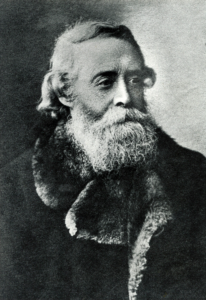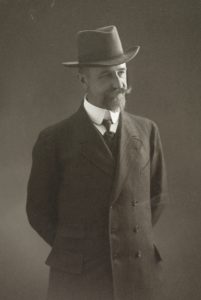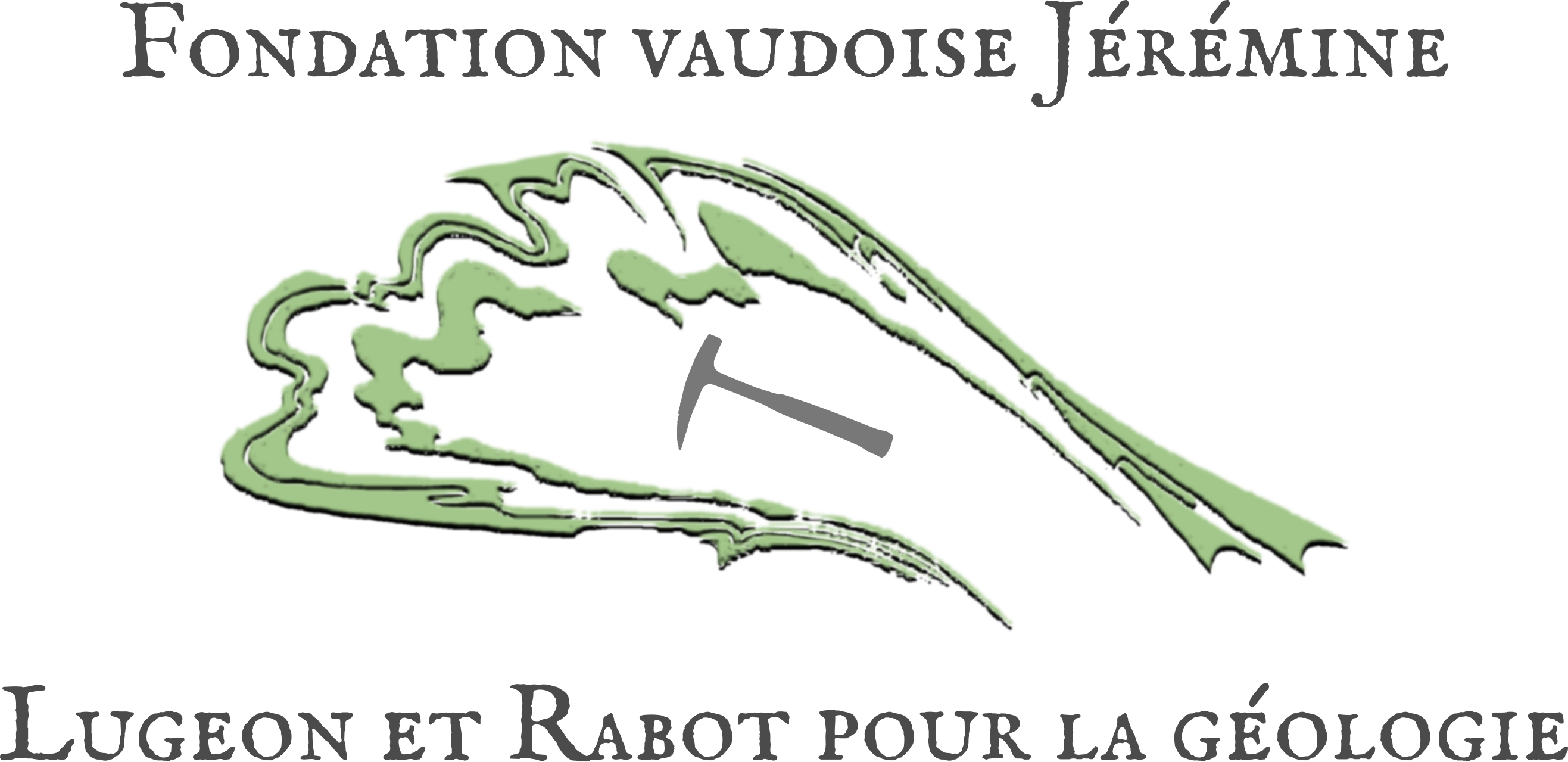The Foundation
The Fondation vaudoise Jérémine, Lugeon et Rabot pour la géologie is a foundation governed by articles 80 and following of the Swiss Civil Code and by the present statutes.
The Foundation aims to contribute financially to the development of geological science at the University of Lausanne (UNIL) and the Cantonal Museum of Geology in Lausanne.
The Foundation was formed in 2003 by the merger of the following four foundations: La Fondation vaudoise pour la géologie, founded by Mrs. Élisabeth Jérémine, La Fondation Maurice Lugeon, Maurice and Ida Lugeon, and La Fondation Charles and Andrée Rabot.
All of these foundations were created by funds from three renowned scientists:
Dr. Elisabeth Jérémine (1879-1964) (Elizaveta Vladimirovna Ereminaest) studied in Petersburg and came to UNIL to do her thesis entitled: "The closed basins of the Pre-Alps", at the invitation of a young and promising professor Maurice Lugeon. She continued her research activities throughout her life and in particular, she became a specialist in petrography. She worked with the two professors at the Sorbonne A. Michel-Lévy and A. Lacroix who are the authors that every microscopist in geology knows the diagram of the same name. Her scientific works are numerous, she has written more than 100 publications. Her fame in Europe is great, she will have many collaborations, and if she had not had the handicap of being a woman, she would certainly have a much greater notoriety nowadays and would have been a professor.
The teacher Maurice Lugeon (1870-1953) is one of the UNIL geologists who made the reputation of the University, known worldwide for his work on dams, his "Lugeon essay" and his understanding of the Alps.
Charles Rabot (1856-1944) was a French geographer who was interested in glaciology in the polar regions. He was a tireless explorer of these regions, with talents as a popularizer. Through his expeditions he made significant contributions in the fields of natural sciences (glaciology, geology, meteorology, etc.). His link with UNIL is that he was named professor honoris causa at the University of Lausanne in 1915.
We would like to thank our illustrious predecessors who have allowed us to produce a history of Lausanne geology.
The President of the Foundation, February 11, 2022
The Lausanne School and the great advances in Geology.
by Aymon Baud and Jean-Luc Epard
The great advances in geology brought by the School of Lausanne are first of all in the fields of discovery and diffusion of the glacial theory. It was discovered by Ignace Venetz and published in 1833 and it is Jean de Charpentier who communicated the new theory to Louis Agassiz who published a year before him, in 1840 a "Study on Glaciers" while in 1841 Jean de Charpentier published his "Essay on Glaciers".

Twenty five years later, Charles Adolphe Morlot clarifies the theory and shows in 1856, the certain existence of two successive ice ages. It is François-Alphonse Forel who founded in 1894 the Swiss Glaciological Commission and who was the initiator in 1895 of the International Commission for the Study of Glaciers. Still in Lausanne, he was succeeded by Paul-Louis Mercanton who, through his work in the polar region and Greenland since 1912, continued until 1960 the work on glaciers initiated by Forel and his predecessors.

A second major advance concerns the stratigraphy with that of the constitution of a reasoned scale of geological times which is due to Eugene Renevier. His " Geological chronograph "This new time scale was presented at the International Geological Congress in Zurich in 1894 and was endorsed by the Congress and published in Lausanne in 1897. This new time scale will have a great repercussion in the international community and the results will be used as standard for the teaching of stratigraphy during all the 20ème century. It will lead to the concept of stage used in stratigraphy, of which a large number of names and typical localities are still in use.
For the Triassicis Jean Guexwhich with Aymon Baudthen president of the sub-commission for the stratigraphy of the Triassic, organized in 1991 an international meeting in Lausanne which defined the 2 stages of the Lower Triassic currently used Induen and Olenekien. And it is the latter that collaborates on a new tool, isotope stratigraphyThis study was used to define the boundary between the Primary and Secondary Eras by the study of carbon isotopes recorded in the succession of sediments of this age (1989).
It is with François-Alphonse Forel that the foundations of the science of lakes, limnology will be specified in Lausanne with his book on "Le Léman" completed in 1904.

The analysis of the mountain ranges made in Lausanne around Eugène Renevier, where the new pioneers of the study of the Alps meet, will lead to the concept of overlaying nappes and then of the transport of all the northern limestone Alps to the whole Alpine massif. First of all Hans Schardt who, following the discoveries of the Triassic age of pre-Alpine limestones considered as Eocene made by his colleagues in Lausanne, corrected his thesis and published in 1893 and 1894 the existence of large overburden sheets which occupy the two pre-Alpine lobes, Romand and Chablais, based on the theories expressed by Marcel Bertrand nine years earlier. Henri Golliez introduced in 1894 the concept of superimposed orogens in the Morcles massif. Then he published in 1897 with Marcel Bertrand the innovative idea of transporting the whole of the northern limestone High Alps northwards. These views were initially strongly opposed by the entire geological community.

But it is Maurice Lugeon who will extend them to the whole Alpine massif up to the Carpathians which, during memorable excursions, will complete to convince the majority of the scientific community.
From the middle of the 20th century, Héli Badoux continues, and sometimes corrects, the work of Lugeon. He worked on the detailed mapping of the Pre-Alps and Helvetic nappes of western Switzerland. He is the main author or a major co-author of 6 sheets of the Geological Atlas of Switzerland 1:25'000 published between 1959 and 1990. He favored detailed observations leading to innovative theoretical developments. His work on the Leytron truncated belemnites (1963) is very frequently cited as a reference in good structural geology books.
As for Emile Argand who studied and wrote his thesis in Lausanne, he brought to the geological science of mountain ranges the completely new notion of collision zone and superposition of one continent on anothershown in his publications of 1909, 1916 and 1924.
In 1926, Paul-Louis Mercanton will bring to light some the magnetic field inversion recorded in the rocks during geological time and he is the first to propose that the recorded magnetism could corroborate the theory of continental drift and make it possible to determine their movement. But it would take 30 years for his new ideas to be verified.
As for Arnold Bersierprofessor at the Institute of Geology and director of the Museum, became an expert in analysis of the sedimentation processes of a foreland basin, the molasseIn 1958, he organized the session of the Vth International Congress of Sedimentology in Lausanne, where he led an excursion and gave a brilliant presentation on the causes and mechanisms of molasse sedimentation. Published in French, his presentation, translated into English, will serve as a basis for the nascent cyclostratigraphy of the 2nd millennium.ème part of the 20ème century and the subdivisions of the western Swiss molasse that he defined will be used for all subsequent studies.
Ms. Alice Schnorf-Steiner who studied Science at the University of Lausanne, began the paleontological study of secondary Stromatopores and presented a remarkable thesis in 1931. Hired in 1952 as curator at the Geological Museum of Lausanne, she continued her studies on stromatopores and one of the great specialists of this group, M. Lecompte, wrote that the work of Mrs. A. Steiner is one of the most important papers published on the structure of Mesozoic Stromatoporoids and their general systematics. In 1963 she became the first female president of the Swiss Paleontological Society.
In Lausanne, applied geology will not be left out with major works dedicated to tunnelsso it is Eugene Renevier which participates in geological surveys of large alpine tunnelsMont Blanc in 1876 and the Simplon in 1878. For the latter, it is Hans Schardt which will follow the drilling, whileHenri Golliez is the architect of the Loetschberg tunnel route and follow-up.
For the layout and follow-up of geological works concerning mountain railroadsis Henri Golliez which is in charge of the route of the famous Jungfraujoch train inaugurated in 1913 as well as the route from Brig to Diesentis with the crossing of the Furka and Oberalp passes.
Maurice Lugeon, him, will continue the work for the geology of the Mont Blanc Tunnel that he will carry out with Nicolas OulianoffThe latter will later be in charge of the geology of the Great St. Bernard Tunnel.

Maurice Lugeon will emphasize the fundamental importance of geological studies for the construction of large dams and the publication of the book on this subject in 1934 will serve as a reference for these works throughout the world and requests for expertise will not cease to flow into Lausanne.
The aerial photography applied to geological mapping of the high mountain system will be the work from 1934 of Nicolas Oulianoff from surveys made by and with Paul Corbin, a French engineer based near Chamonix. Inventor of a geologist's compass named after him and presented in 1941, this one, manufactured in Switzerland by Meridian, will be used all over the world by geological cartographers.
